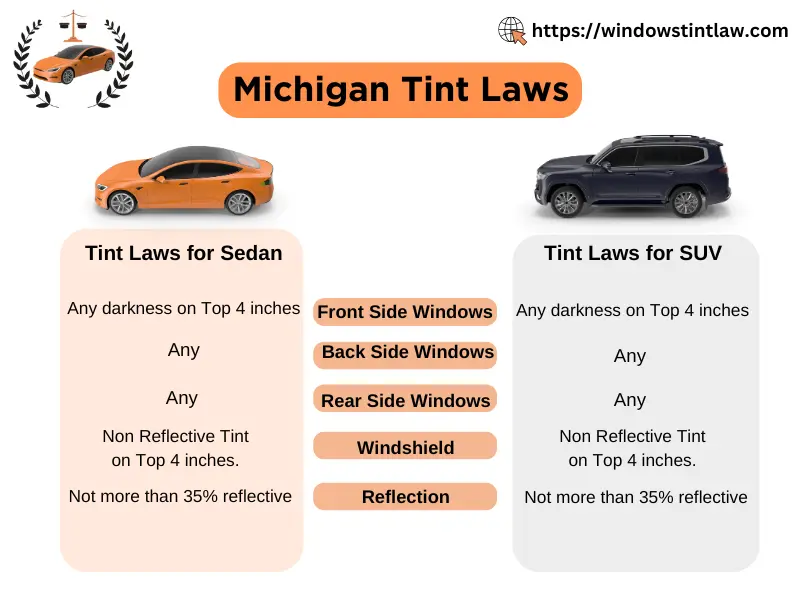Michigan Tint laws were imposed and regulated in 2000 to ensure vehicles shouldn’t have tinted windows beyond a certain limit.
Obeying Window tint laws provides safety to the drivers and passengers on road, while reducing the risk of accidents. As the illegal tints obstructs the driver’s view by reducing the visibility.
Tinted windows offer several advantages, but following tint laws is mandatory to avoid legal actions from the state departments.
The darkest legal tint in Michigan and permissible tint reflection limits and other rules are mentioned in the below sections.
Overview of Michigan Tint Laws
The below image outlines the allowed limits for Tint Darkness and Tint Reflections for Cars and SUV’s or Trucks.

Darkest Legal Tint in Michigan
The below table shows the allowed tint percentage in terms of darkness and reflection. All motor vehicles registered in Michigan must follow these limits to avoid tint tickets.
| State | Front Side Windows | Back Side Windows | Rear Window | Windshield | Tint Reflection | Other Restrictions |
| Michigan | Any darkness can be applied on top 4 inches. | Any | Any | Non reflective tint on top 4 inches is permitted, regardless of AS1 line. | Not more than 35% reflective. | Silver and Gold color tints are restricted. |
If you are resident of any other state, you must check tint laws for your state before applying any tinting materials on vehicle windows.
Window Tint Reflection
According to Michigan Compiled Laws for Motor Vehicles, Section 257.709 states that any person shall not operate the motor vehicle with a rear window of back side windows covered with a tinted material with a solar reflectance of more than 35% in the visible light. Further to this, windows must not have Gold or Silver Colored reflective tints.
Hence, any individual must know which type of tint is right choice to install while following the Michigan State laws for reflective window tint. As some tint materials are reflective, which produces shiny appearance.
Other Rules and Regulations
Motorists in Michigan should know the other rules and regulations for vehicles with Tinted windows:
- Dual Side Mirrors: 2 rear view mirrors on each side is mandatory, if rear window’s view is obstructed.
- Restricted Tint Colors: Silver and Gold Tint colors are restricted.
- Sticker: Not required as per the state laws for motor vehicles.
- Certificate: Not specified in the Motor Vehicle Codes.
Medical Exemptions
Michigan compiled laws for motor vehicles allows any individual with certain medical conditions to apply special window treatment or lower tints on vehicle.
The vehicle owner or operator must have the letter signed by a licensed physician or optometrist, indicating that special window treatment is a medical necessity. Special window treatment allows individual to install the darker tints to avoid direct sunlight, as the dark tints have less VLT percentage, which is feasible for person who don’t want exposure to direct sunlight.
Further to above, the special tint should not be too dark that it could obstruct the driver’s vision.
Penalties For Violating Michigan Tint Laws
If any vehicle owner or driver caught with illegal tint, fix-it ticket (to replace or remove the unlawful tint) is usually issued on the first attempt.
For the Second time, if you caught with same offense $25 tint ticket shall be issued by the police and two points added to your driving record. Subsequent offenses can have more serious consequences, it might add more points to driver’s record which can lead to suspension of driving license. Vehicle Operator may get pulled over by the police in case of non-compliance with state laws for repeated times.
We highly recommend you to adhere with the state laws to avoid hefty fines and caught by the police.
